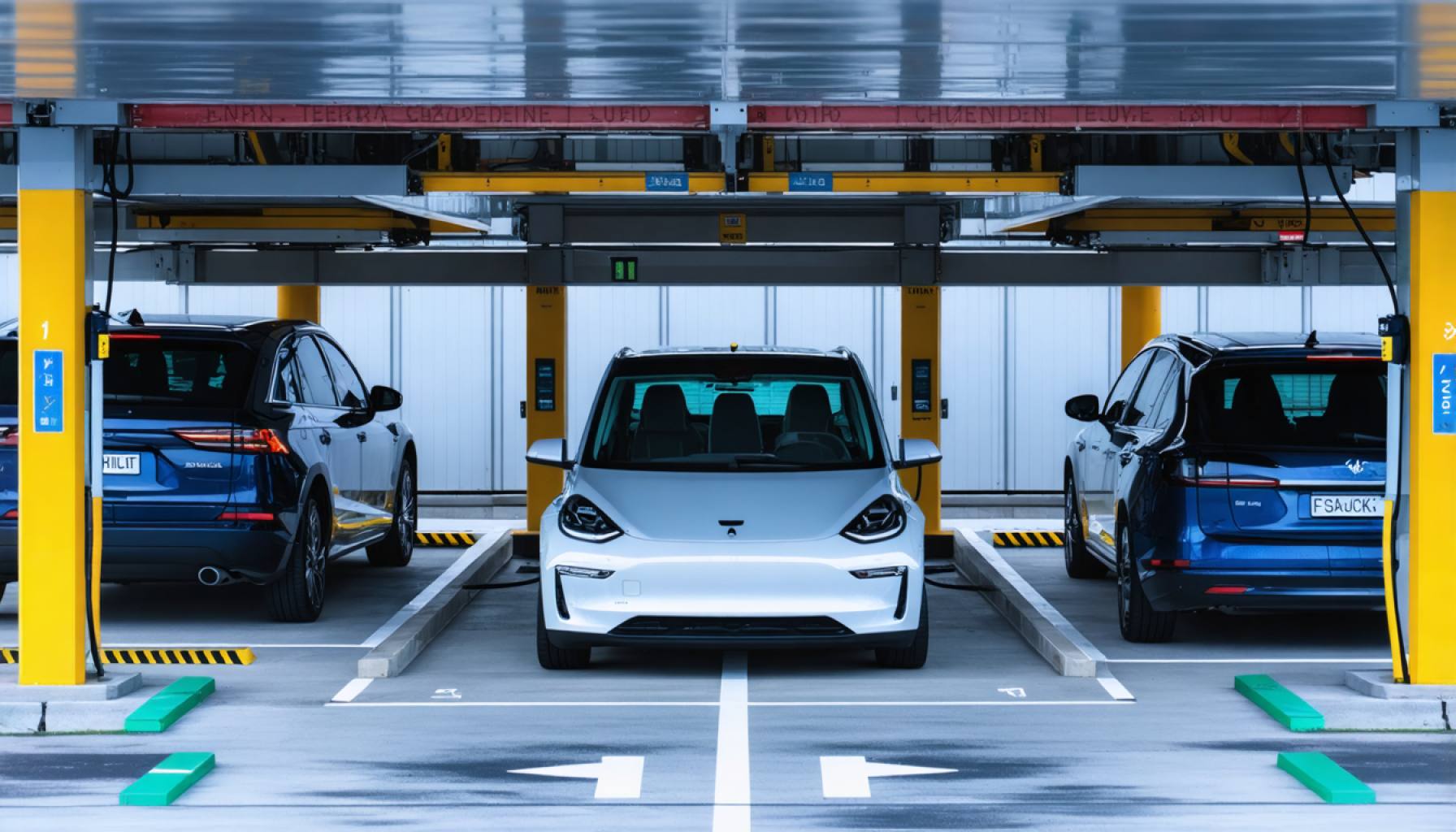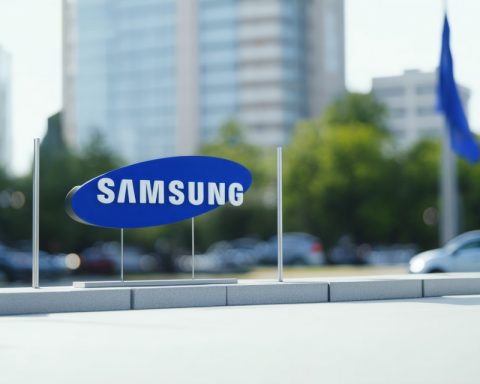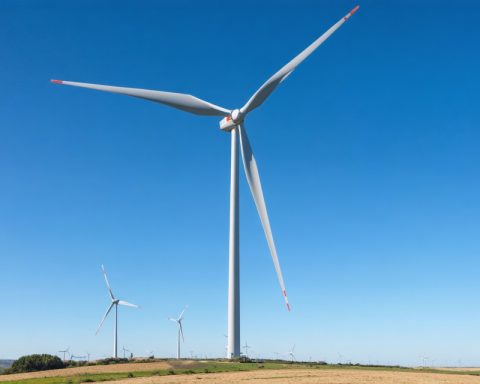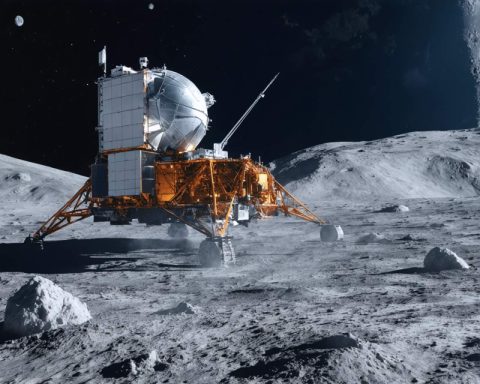- Electric vehicles are increasingly prevalent, yet charging infrastructure in urban areas remains insufficient.
- Terra Charge and IHI Fusou Engineering have partnered to enhance EV charging solutions in high-rise buildings with mechanical parking systems.
- This collaboration addresses the complex integration of EV chargers in sophisticated lift-and-store parking facilities, overcoming spatial and mechanical challenges.
- IHI Fusou’s expertise in parking solutions, with over 10,000 annual installations, facilitates broader residential charging expansion in Japan.
- The initiative supports Japan’s goal of improving EV charging access, crucial for the 82.3% of potential EV owners lacking home charging facilities.
- Terra Charge introduces an intuitive, app-based service for seamless user access, enhancing the user experience significantly.
- This partnership signifies a major step toward a sustainable, carbon-neutral future, making EV charging accessible and routine.
Electric vehicles (EVs) are no longer the distant future; they’re the vibrant now. Yet, even as their presence on our roads accelerates, the infrastructure to support them often lags, especially in densely populated urban areas. Here, Terra Charge steps onto the stage, unveiling a transformative collaboration with IHI Fusou Engineering that could redefine urban parking paradigms and expedite EV adoption across Japan.
Imagine the heart of Tokyo—where space is at a premium and skyscrapers reach for the sky. In these bustling environs, Terra Charge and IHI Fusou envision a blend of mechanical ingenuity and sustainable technology that turns the often-underutilized corners of parking facilities into EV charging sanctuaries. This partnership brings a critical innovation to one of the thorniest challenges for urban EV adopters: charging accessibility in high-rise residential buildings with mechanical parking systems.
Historically, integrating EV chargers into these sophisticated lift-and-store parking arrangements has been a conundrum. The challenges are spatial and mechanical, involving the interplay of vehicle dimensions, charging infrastructure, and the intricate dance of automated platforms. Previous endeavors often hit dead ends with cables threatening to snag, jeopardizing both chargers and vehicles. Now, Terra Charge and IHI Fusou have elegantly sidestepped these pitfalls.
Employing IHI Fusou’s prowess in parking solutions, recognized by over 10,000 annual installations, the alliance introduces wider palettes accommodating EV chargers. These enhancements negate previous spatial constraints, enabling residents to charge their vehicles seamlessly as part of a broader, residential charging expansion effort envisaged by Japan’s Ministry of Economy, Trade, and Industry.
The move couldn’t come sooner for EV enthusiasts. A recent survey highlights that a staggering 82.3% of potential EV owners residing in residential buildings report inadequate charging provisions at home—a critical barrier to broader EV adoption. Terra Charge’s app-based service—designed with simplicity and user-friendly functionality, from effortless registration to around-the-clock support—complements this infrastructure leap, ensuring users can access charging facilities as intuitively as hailing a taxi.
This confluence of technology and strategy signals more than just improved amenities; it heralds a future where EV charging is as mundane and accessible as plugging in a smartphone. As our cities grow skywards, Terra Charge and IHI Fusou’s innovation invites us to consider new horizons, where sustainable living is woven seamlessly into daily life.
The revolution is humming to life, garage by garage, charging port by charging port. As these projects take hold, Terra Charge and IHI Fusou illuminate a path toward a carbon-neutral future, promising a world where choosing an EV is as simple as finding a spot to charge it.
How Terra Charge and IHI Fusou Are Transforming Urban EV Charging
The Future of Urban EV Charging Is Here
Electric vehicles (EVs) are becoming an integral part of our transportation landscape. However, their proliferation in urban areas is often stifled by inadequate charging infrastructure. With their recent collaboration, Terra Charge and IHI Fusou are poised to revolutionize this sector, particularly in densely populated regions like Tokyo.
Understanding the Challenge
In urban centers with high-rise residential buildings, space is at a premium and integrating EV chargers into existing mechanical parking systems presents a unique set of challenges:
– Space Constraints: Mechanical parking systems need to efficiently store vehicles without obstructing movement. Introducing charging cables or stations must not hinder these operations.
– Safety and Practicality: Chargers must be positioned to avoid getting caught in the lift mechanisms, which could result in damage to vehicles or the infrastructure itself.
– User Accessibility: For EV adoption to increase, charging must be as convenient and intuitive as traditional refueling methods.
Innovative Solutions by Terra Charge and IHI Fusou
Employing innovative design and technology, this collaboration aims to address these challenges head-on:
– Advanced Parking Solutions: IHI Fusou brings its extensive expertise in parking systems, boasting over 10,000 installations annually, to create adaptable platforms that integrate EV chargers seamlessly.
– App Integration: Terra Charge’s app simplifies the charging process, offering easy registration and continuous support, making EV charging as straightforward as ordering a ride-sharing service.
– Enhanced User Experience: Wider palettes and sophisticated engineering ensure that charging facilities are more accessible and user-friendly, removing historical barriers.
Pressing Questions Answered
1. What Makes This Collaboration Significant?
– The partnership introduces a scalable model for urban EV infrastructure, addressing both technical and user experience challenges which have historically hindered EV adoption in residential high-rises.
2. How Does This Impact Urban EV Adoption?
– The increased availability of user-friendly charging options is expected to significantly boost the confidence of potential EV buyers, addressing the 82.3% of surveyed apartment residents who find current provisions inadequate.
3. Is This Technology Sustainable?
– Absolutely. By making EV charging more accessible, these solutions support Japan’s broader sustainability goals, aligning with the Ministry of Economy, Trade, and Industry’s efforts to expand residential charging infrastructure.
Market Forecasts and Industry Trends
– Growth in Urban Charging Solutions: With increasing urbanization, the demand for versatile charging options is set to rise, making innovations like those from Terra Charge and IHI Fusou pivotal.
– Government Support: Continued backing from government bodies will be crucial, potentially offering subsidies or incentives for residential buildings to adopt such technologies.
Actionable Recommendations
– For Building Managers: Consider initiating a dialogue with companies like Terra Charge to explore how these solutions can be tailored to your facilities.
– For Potential EV Owners: Keep an eye on developments in residential charging infrastructures, as these enhancements could significantly impact your buying decision and daily convenience.
– For Municipal Planners: Work with technology developers to understand the best integration practices for new and existing residential complexes.
Exploring these solutions can lead to a smoother transition to a sustainable, EV-friendly urban environment, revolutionizing how we live and move through city landscapes.
For more insights into EV technology trends and how they’re shaping our future, visit the Terra Charge website at Terra Charge and learn more about IHI Fusou at IHI.

















